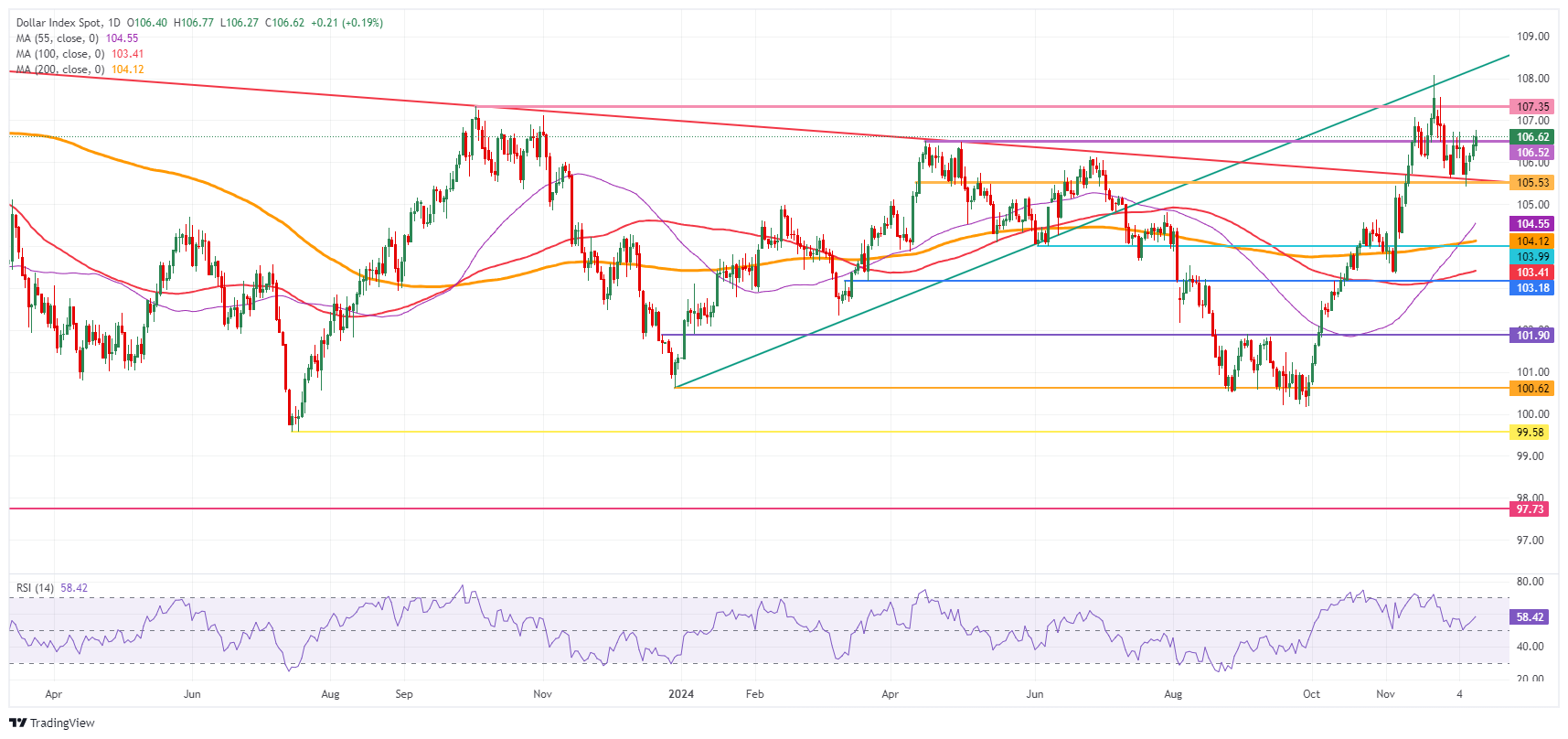- US Dollar rises slightly ahead of US CPI report for November.
- Traders have already boosted the US dollar amid high expectations of a higher-than-expected figure.
- The US Dollar Index (DXY) is trading around 106.50 and eyes 107.00 on the upside.
The US dollar (USD) rises on Wednesday, extending the winning streak that began on Friday. The greenback is enjoying some safe haven flows due to recent events in Syria after former president Bashar al-Assad fled the country as rebels took control. This adds to jitters about the fragile balance of peace residing in the region after Israel and Hezbollah agreed to a ceasefire.
The main item on Wednesday’s economic calendar is the release of the US Consumer Price Index (CPI). The monthly release of both headline and core CPI will garner the most attention. Any reading that exceeds expectations could dampen expectations of an interest rate cut by the Federal Reserve (Fed) next week.
Daily Market Summary: Latest CPI Print to Decide
- At 13:30 GMT, the US Consumer Price Index (CPI) for November will be published:
- Monthly headline inflation is expected to head to 0.3%, from 0.2%. The annual indicator should rise to 2.7% from 2.6%.
- Monthly core inflation is expected to increase by 0.3%, the same pace as the previous month. The annual underlying measure should also remain at 3.3%.
- Any figure below consensus will likely weaken the US dollar as the odds of a Fed rate cut next week would increase. On the contrary, a reading above consensus will decrease the odds of a rate cut and should lead to further appreciation of the US Dollar.
- Stocks are struggling this Wednesday with investors worried about geopolitical tensions breaking out in the Middle East. European indices are generally down by less than 0.50%. US futures are trading fairly flat.
- The CME FedWatch tool is pricing another 25 basis point (bps) rate cut by the Fed at the December 18 meeting at 86.1%. A 13.9% probability is that rates will remain unchanged.
- The US 10-year benchmark rate is trading at 4.23%, retreating slightly from its peak this week at 4.24% on Tuesday.
DXY Dollar Index Technical Analysis: Band Range
The US Dollar Index (DXY) is defining a band range that could hold into next year given the limited number of data points remaining. The release of the US Consumer Price Index (CPI) will likely determine whether that range will be between 105.50 and 107.00 or between 105.50 and 108.00.
The US Dollar bulls have reclaimed 106.52 (April 16 high), which was a tough trade to overcome. The next level is the round of 107.00 and 107.35 (high of October 3, 2023). Higher up, the November 22 high emerges at 108.7.
Looking down, the crucial level at 105.53 (April 11 high) comes into play before heading towards the 104 region. If the DXY falls to 104.00, the big number and the 200-day SMA at 104.03 should catch any falling knife formation.
DXY Dollar Index: Daily Chart
Inflation FAQs
Inflation measures the rise in prices of a representative basket of goods and services. General inflation is usually expressed as a month-on-month and year-on-year percentage change. Core inflation excludes more volatile items, such as food and fuel, which can fluctuate due to geopolitical and seasonal factors. Core inflation is the figure economists focus on and is the target level of central banks, which are mandated to keep inflation at a manageable level, typically around 2%.
The Consumer Price Index (CPI) measures the variation in prices of a basket of goods and services over a period of time. It is usually expressed as a percentage of inter-monthly and inter-annual variation. Core CPI is the target of central banks as it excludes food and fuel volatility. When the underlying CPI exceeds 2%, interest rates usually rise, and vice versa when it falls below 2%. Since higher interest rates are positive for a currency, higher inflation usually translates into a stronger currency. The opposite occurs when inflation falls.
Although it may seem counterintuitive, high inflation in a country drives up the value of its currency and vice versa in the case of lower inflation. This is because the central bank will typically raise interest rates to combat higher inflation, attracting more global capital inflows from investors looking for a lucrative place to park their money.
Gold was once the go-to asset for investors during times of high inflation because it preserved its value, and while investors often continue to purchase gold for its safe haven properties during times of extreme market turmoil, this is not the case. most of the time. This is because when inflation is high, central banks raise interest rates to combat it. Higher interest rates are negative for Gold because they increase the opportunity cost of holding Gold versus an interest-bearing asset or placing money in a cash deposit account. On the contrary, lower inflation tends to be positive for Gold, as it reduces interest rates, making the shiny metal a more viable investment alternative.
Source: Fx Street
I am Joshua Winder, a senior-level journalist and editor at World Stock Market. I specialize in covering news related to the stock market and economic trends. With more than 8 years of experience in this field, I have become an expert in financial reporting.








